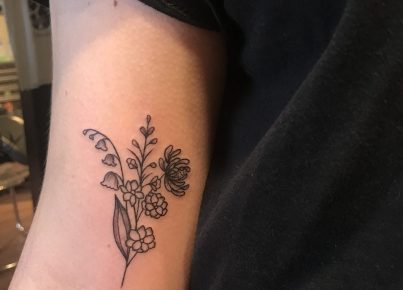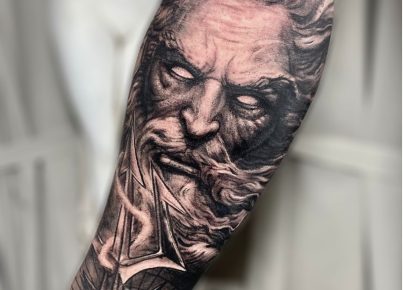
Sai Ohm Kan Satru, or ยันต์สายโอมกันศัตรู in Thai script, is a sacred tattoo design woven with cultural and spiritual threads
It is a popular design in the Sak Yant (also known as “Thai Traditional”) tattooing style
You can read a detailed article about Sak Yant here
Like many phrases in Thai, it doesn’t really have a direct translation to English
A good summary of what it means is “A sacred rune to protect you from danger and enemies”
If we break it down word for word:
- Sai Ohm = with the Ohm symbol included
- Kan = Protect
- Satru = Enemy or Danger
The significance of this tattoo is to provide the wearer not only with protection against enemies and dangers
But it does so by providing them with a greater connection to consciousness
So it really isn’t talking about just physical protection, but spiritual too
It is believed to give you protection from the worldly influences that can affect your spiritual journey and mental health
The letters in the Sai Ohm Kan Satru are written in a language called Khom
The Khom script traces its lineage back to the ancient Brahmi script of India
This distinctive alphasyllabic writing system has seen widespread use across Cambodia, Laos, Vietnam, and notably Thailand
Within Buddhist and Hindu ceremonies, it maintains a distinguished position
The relevance of Khom script is significantly amplified within Sak Yant, the sacred tattoos of Thailand
It’s said to hold potent spiritual energy and is used to inscribe various symbols and mantras
This script, a treasured inheritance, has been transferred across generations of Sak Yant masters, preserving its spiritual resonance and authenticity
Though the modern Thai script and Khom script share the same Brahmi roots, Khom has had considerable transformations over time
Despite sharing a common ancestry, these scripts now possess unique visual characteristics and usage rules
The modern Thai script is predominantly used for daily communication in Thailand, while the Khom script retains its crucial role in religious, ceremonial, and traditional contexts like Sak Yant
In Sak Yant, the use of Khom script isn’t just for its physical inscription
It serves as a spiritual bridge, linking the wearer to the deep-seated cultural heritage, historical continuity, and spiritual vitality encapsulated in this ancient script
The usage of the script in the Sai Ohm Kan Satru design isn’t able to be “read” in the way we generally understand it
It’s meant to invoke certain meanings and protections in a way that the original Ajarn (Sak Yant master) decides
Our designs are sourced from famous Ajarns and checked for authenticity
So while we can’t tell you what it “says”, we are able to explain the meaning

In the Sai Ohm Kan Satru design, the important Buddhist symbol, the unalome, represents a path towards spiritual enlightenment
The unalome’s complex twists and turns aren’t just random
They are metaphoric signposts on the spiritual quest
The journey isn’t a straight line and there are going to be setbacks and obstacles
sometimes causing a backward movement before progressing forward.
When the winding path finally straightens, it signifies achieving enlightenment, a state of clarity in both the mind and spirit
The Sai Ohm Kan Satru design includes unalomes in three orientations – vertical, horizontal, and diagonal
A unalome oriented vertically represents an aspiration to reach a higher spiritual plane
A horizontal unalome illustrates the balance of spiritual growth amidst worldly distractions and experiences
Interestingly, the diagonal unalome in the design signify the dynamic nature of the spiritual path
Emphasizing that it isn’t strictly vertical or horizontal but is a journey taken in all directions as one navigates through life’s experiences
The Sai Ohm Kan Satru design then symbolizes a three-dimensional spiritual journey.
The design demonstrates that through spiritual evolution (vertical), worldly experiences (horizontal), and a balance between the two (diagonal), we can make progress towards our spiritual goals
The Sai Ohm Kan Satru is more than an artwork, it’s a spiritual blueprint
Its energy is drawn from centuries-old traditions, passed down through generations of Sak Yant masters
It is, also, a beautiful piece of art!
It’s entirely a personal choice what the tattoo means to you, and nobody is going to judge you for that
Whether you want it for the deep rooted spiritual and cultural meanings
Or just think it’s a beautiful meaningful design that you’d love to have on your body
It’s entirely your choice
Diving deep into the cultural reservoir of Hinduism, Buddhism, and Jainism, the Ohm (or Aum) symbol emerges as one of the most iconic and sacred symbols
Most people are familiar with the Hindu version of the Ohm symbol

With its roots dating back thousands of years, the Ohm symbol can be found not only in ancient scriptures but also in numerous art forms, meditative practices, and even, tattoo art
Crafted out of three Sanskrit letters – aa, au, and ma, when combined, the Ohm symbol represents the trinity of life – the waking state, dream state, and deep sleep state
The version found in the Sai Ohm Kan Satru design has the same exact meaning but is the Khom version of the symbol

Universally embraced as the primordial sound of the universe, it’s believed that chanting ‘Ohm’ in meditation connects us to the divine vibrations of the cosmos
Its importance goes beyond religion and philosophy, acting as a spiritual guide, a protector, and a provider of harmony and peace in people’s lives
In the context of Sak Yant tattoos, the Ohm symbol represents protection, divine connection, peace, and spiritual enlightenment
The Ohm symbol is a tiny testament to the vast cosmic truth, serving as a visual and sonic reminder of the profound connection between the universe and the beings within it
The most popular position for this design is on the spine
This is because it fits nicely in the center of the back
However, you’re completely free to choose the position with only one rule
In Buddhist belief, the lower part of the body below the waist is seen as unclean
For this reason, it can be considered offensive to have a Sak Yant tattoo below the waist
As we operate in a way that wants to respect and celebrate Thai culture, we won’t do any Sak Yant tattoo below the waist
Apart from that, the choice is entirely yours!
At ALL DAY Tattoo, we honor this cultural heritage with every tattoo
Our studio in Bangkok is fully licensed, and we strictly adhere to Western hygiene practices
We use only premium, FDA-approved inks from the USA, ensuring vibrant longevity for your tattoo
Choosing us means choosing a fair and transparent process, free from tourist tricks or scams
Our central location in Bangkok makes us easy to find
Our team of friendly, English-speaking professionals are always ready to guide you through the process of getting your Sai Ohm Kan Satru tattoo
Feel free to reach out to us through any of the contact methods below to get started






